#environmental interpreter
Explore tagged Tumblr posts
Text
My Role as an Environmental Interpreter
After reading Who Offers Interpretation? from our textbook, I have come to realize that my ideal role would be as an environmental interpreter in an aquarium. The role of an interpreter, especially in the context of nature and aquatic environments, is to deliver information in ways that captivate and educate visitors. The goal is to enhance their experience while promoting a deeper appreciation for the wonders of the natural world.
My role as an interpreter could entail leading guided tours where guests can experience animal exhibits more intimately and educationally. I would also create and arrange hands-on educational programs for children and adults, ensuring every visitor leaves with a better understanding of aquatic ecosystems. In addition to in-person interactions, I could help design interpretive signs that combine real-life and cartoon visuals with fun memorable facts, as well as include the signages into mobile apps with a fun twist of interactive stories and quizzes to enhance accessibility and engagement when in the aquarium, or at home! In addition, I would be responsible for sharing knowledge about various aquatic habitats, from coral reefs and mangroves to the various types of aquatic organisms in the facility. This role would involve much more than simply reciting facts, it would mean bringing the underwater world to life through enthusiastic storytelling, interactive discussions, and engaging activities. Answering visitor questions would be an integral part of this role, as it would help create meaningful connections to the aquatic life they’re learning about and seeing in the vicinity.



To be successful as an aquatic life interpreter, I would have to develop a range of skills, such as communication and creativity. Strong communication and public speaking abilities would be essential, as I would need to recite information from several exhibits in an engaging and manageable way to maintain the crowd's attention. (There is nothing worse than a guide who is visibly not passionate about their tour). Creativity and adaptability would also be crucial for creating unique programs and responding to diverse visitor needs, as we all learn differently. Additionally, a sense of humour and the ability to connect with people of all ages would make my interpretation more enjoyable and memorable for visitors. Last but not least, a deep passion for aquatic life and the environment would be vital, as enthusiasm can inspire others to care more deeply about the topics being presented. (Luckily for me, I have always loved the ocean and marine life. I have attached some photos of my Dad and me scuba diving.)


References
Beck, L., Cable, T. T., & Knudson, D. M. (2018). Interpreting cultural and natural heritage: For A Better World. SAGAMORE Publishing, Sagamore Venture.
8 notes
·
View notes
Text
Unveiling the Underwater Symphony: The Marvels of Coral Reef Symbiosis🐠
Hey fellow nature lovers! Today, I'm thrilled to share with you one of the most extraordinary marvels of the natural world that never fails to fill me with wonder: the intricate dance of symbiosis in coral reefs.
Imagine plunging beneath the surface of the ocean, into a vibrant underwater world teeming with life. Here, nestled among the coral colonies, exists a delicate balance of cooperation and mutual benefit that has evolved over millions of years (National Oceanic and Atmospheric Administration [NOAA], 2024; NOAA, n.d.)
At the heart of this underwater paradise are the corals themselves, tiny organisms that build intricate calcium carbonate skeletons, forming the backbone of the reef ecosystem (Lippsett, 2018). But what truly sets coral reefs apart is their mutualistic relationship with algae known as zooxanthellae (NOAA, n.d.). You can catch a glimpse of these symbiotic organisms in the image below:

Direct photograph link: https://www.tetiaroasociety.org/biosphere-tetiaroa/zooxanthellae :)
These microscopic algae live safely within the tissues of the coral, harnessing the power of sunlight to photosynthesize and produce energy (NOAA, n.d.). In return, they provide the coral with essential nutrients like glucose, helping to fuel their growth and survival (NOAA, n.d.). It's a partnership so vital that without it, coral reefs as we know them would cease to exist (NOAA, n.d.).
But the wonders of symbiosis don't stop there. Coral reefs are also home to a dazzling array of marine life, from colourful fish and graceful sea turtles to elusive lobsters and enchanting seahorses (NOAA, 2024). Each species plays a unique role in the reef ecosystem, contributing to its resilience and diversity.
What's truly remarkable about coral reefs is their ability to adapt and thrive in some of the most challenging environments on Earth (Harvey et al., 2018). From the crystal-clear waters of the tropics to the murky depths of the deep sea, corals have evolved a remarkable array of shapes, sizes, and colours to ✨ thrive and survive ✨ (Harvey et al., 2018).
But perhaps the most exciting aspect of coral reef interpretation lies in its potential to inspire action and conservation (NOAA, 2024). As we continue to explore and understand these underwater wonders, we uncover not only the secrets of the ocean but also the urgent need to protect and preserve it for future generations (NOAA, 2024).

Direct photograph link: https://www.couriermail.com.au/news/queensland/whitsunday/reef-protest-surprises-mp/news-story/c8ba89c08b93307b13bb913ae7ac3894 :)
Imagine a future where every person, young and old, feels a deep connection to the ocean and understands the vital role that coral reefs play in sustaining life on Earth. A future where conservation efforts are driven not only by scientific research but also by a shared sense of awe and wonder at the beauty and complexity of the natural world. This embodies the "bright future of interpretation" Beck et al. (2018, p. 457) envisioned – a future where every discovery, every moment of awe, fuels our passion for understanding and protecting the wonders of the natural world.
So, the next time you find yourself daydreaming about the ocean, take a moment to marvel at the intricate dance of symbiosis unfolding beneath the waves. And remember, the wonders of nature are all around us, just waiting to be discovered and appreciated! Until next time :)
Madison B.
References:
Beck, L., Cable, T. T., & Knudson, D. M. (2018). Interpreting Cultural and Natural Heritage: For a Better World. Sagamore Publishing.
Harvey, B. J., Nash, K. L., Blanchard, J. L., & Edwards, D. P. (2018). Ecosystem‐based management of coral reefs under climate change. Ecology and Evolution, 8(12), 6354–6368. https://doi.org/10.1002%2Fece3.4146
Lippsett, L. (2018, November 12). How Do Corals Build Their Skeletons? Oceanus. https://www.whoi.edu/oceanus/feature/how-do-corals-build-their-skeletons/
National Oceanic and Atmospheric Administration. (n.d.). Zooxanthellae … What's That?. National Ocean Service. https://oceanservice.noaa.gov/education/tutorial_corals/coral02_zooxanthellae.html#:~:text=The%20corals%20and%20these%20special,the%20coral%20to%20remove%20wastes.
National Oceanic and Atmospheric Administration. (2024, January 18). What species live in and around coral reefs?. National Ocean Service. https://oceanservice.noaa.gov/facts/coral_species.html#:~:text=Millions%20of%20species%20live%20in%20and%20around%20coral%20reefs&text=Fish%2C%20corals%2C%20lobsters%2C%20clams,thousands%20of%20years%20of%20history.
3 notes
·
View notes
Text
Unit 2 Blog Post: My Ideal Role As An Environmental Interpreter
I thought this week’s blog prompt was very interesting! I am excited to hear everyone’s thought’s and opinions regarding it!
An environmental interpreter is a professional crucial to helping others understand the natural world through sharing their knowledge of ecosystems, wildlife, conservation actions and current environmental issues. This role goes much further than just education, as it engages individuals emotionally and helps them to foster a deeper relationship with nature.
Important Assets to Have as an Interpreter:
As an interpreter, strong communication and social skills are essential, as they are the main tools used to convey information, engage audiences, and motivate action on environmental issues. Effective communication skills help strengthen the meaningful connections between nature and your audience, fostering motivation for positive change.
The natural world, with its complex processes, can often seem like a mundane topic, but with the right approach, it can become a source of inspiration and action. As a nature interpreter, it’s your role to take your knowledge and transform it into engaging, creative, and impactful ways to share with your audience. Understanding how to make complex concepts accessible and exciting is key to sparking curiosity and connection. Knowing how to connect with people through auditory, visual and hands on education is an essential skill for a nature interpreter. Since you're likely to have a diverse audience with varying learning styles, understanding these differences and knowing how to apply this knowledge is incredibly valuable. It will help ensure that your audience has an engaging experience and walks away feeling impacted by the information you've shared.
My Ideal Role in Environmental Interpretation:
My ideal environmental interpreter role would be in sustainability consultation and eco-tourism. I have a deep love for teaching and would be thrilled to have the opportunity to share my passion and inspire future generations, while educating businesses to hopefully make more sustainable decisions. Working in the environmental interpretation industry as a sustainability consultant is very valuable, as they help organizations, businesses and communities understand the importance of sustainable practices and how to implement them. Through business proposals, public presentations, interactive demonstrations and media campaigns, there are many approaches to starting engaging conversations. Sustainability has been something I was always passionate about, as I have always engaged in events such as tree planting. I am a very social and patient person, and I believe those qualities combined with my passion would help me excel as an environmental interpreter.
My ideal role would be based in the Florida mangroves, a place I've always been fascinated by due to my deep interest in marine life. I’d love the opportunity to expand my own knowledge while sharing it with others. During a recent trip to Florida, I had the chance to take an 8-hour kayak tour through the mangroves, where we encountered marine life ranging from starfish and crabs to pufferfish. It was an incredible experience, and my dream job would be to lead similar tours, educating others while showcasing the stunning beauty of the ecosystem. Attached are a few images of the beautiful wildlife I got to encounter!



0 notes
Text
The Philosophy of the Sublime
The sublime is a concept in philosophy and aesthetics that refers to an experience of awe, grandeur, and wonder, often evoking a mixture of fear and admiration. This notion has been explored by various philosophers and thinkers throughout history, particularly in the context of nature, art, and human experience. Here’s an in-depth exploration of the philosophy of the sublime:
1. Historical Origins
Edmund Burke: In his work "A Philosophical Enquiry into the Origin of Our Ideas of the Sublime and Beautiful" (1757), Burke distinguished between the beautiful and the sublime. He associated the sublime with vastness, infinity, and power, which can overwhelm and inspire a sense of awe and terror.
Immanuel Kant: In "Critique of Judgment" (1790), Kant elaborated on the sublime as something that transcends normal human experience and comprehension. He identified two forms of the sublime: the mathematical sublime, related to the vastness of nature and the universe, and the dynamical sublime, related to the power and force of natural phenomena.
Romanticism: The Romantic poets and artists, such as William Wordsworth, Samuel Taylor Coleridge, and Caspar David Friedrich, celebrated the sublime in nature, emphasizing the emotional and spiritual responses to its grandeur and beauty.
2. Key Characteristics of the Sublime
Vastness and Infinity: Experiences or objects that are vast in scale, such as mountains, oceans, or the night sky, evoke a sense of the sublime. Their immensity challenges human perception and comprehension.
Power and Terror: The sublime often involves elements of danger and power, such as thunderstorms, hurricanes, or erupting volcanoes. These evoke fear but also admiration for their majesty and force.
Transcendence: The sublime experience transcends ordinary understanding and evokes a sense of something greater than oneself. It can lead to feelings of humility and reverence.
Aesthetic Experience: In art and literature, the sublime is associated with works that evoke profound emotional responses, often through depictions of nature’s grandeur or human achievement.
3. Philosophical Implications
Human Limits: The concept of the sublime highlights the limitations of human perception and understanding. It suggests that there are aspects of existence that are beyond human control and comprehension.
Emotional Complexity: The sublime evokes complex emotions that combine fear, awe, wonder, and admiration. This complexity enriches human experience and understanding of the world.
Nature and the Divine: The sublime often leads to reflections on the relationship between nature and the divine. The overwhelming power and beauty of nature can evoke a sense of the divine presence or the transcendental.
4. The Sublime in Art and Culture
Visual Arts: Artists like J.M.W. Turner and Caspar David Friedrich captured the sublime in their depictions of natural landscapes and phenomena, emphasizing vastness, power, and emotional depth.
Literature: Writers such as Mary Shelley and Lord Byron explored the sublime in their works, using language to evoke the awe and terror of natural and supernatural elements.
Modern Interpretations: Contemporary artists and thinkers continue to explore the sublime in various forms, including digital art, cinema, and virtual reality, pushing the boundaries of what can evoke awe and wonder.
5. Critiques and Evolving Perspectives
Subjectivity: Some critics argue that the experience of the sublime is highly subjective and culturally specific. What one person finds sublime, another may not.
Environmental Ethics: The concept of the sublime has been revisited in discussions about environmental ethics, emphasizing the need to protect and preserve the natural landscapes that evoke these profound experiences.
The philosophy of the sublime explores the profound and often overwhelming experiences of awe, grandeur, and wonder in response to nature, art, and human achievement. It challenges human limits of perception and understanding, evoking complex emotions and reflections on the transcendental. From its historical origins in the works of Burke and Kant to its manifestations in Romantic art and contemporary culture, the sublime remains a powerful and enduring concept in philosophy and aesthetics.
#philosophy#epistemology#knowledge#learning#education#chatgpt#Philosophy Of The Sublime#Aesthetics#Edmund Burke#Immanuel Kant#Romanticism#Nature And Transcendence#Emotional Complexity#Vastness And Infinity#Power And Terror#Art And Literature#Environmental Ethics#Modern Interpretations#Human Limits#Divine Presence#Subjectivity#sublime#psychology#nature
8 notes
·
View notes
Text
Role of Nature Interpretation in Environmental Stewardship
Before starting this course and my placement as an Outdoor Education Intern, I put greater emphasis on scientific evidence as one of the most important ways to get people to care about environmental issues. I thought that if everyone knew the alarming facts of climate change or the rapid decline of wildlife, people would strive to make the drastic changes needed to address these issues. However, by focusing on only the science many people become disinterested or so overwhelmed that they feel powerless. Whether at a National Park, school or online forums, nature interpretation programs allow people to build emotional connections to nature while learning about the natural world and the importance of sustaining the earth's resources.
While working as an Outdoor Education Intern at the Etobicoke Outdoor Education Centre (EOEC) for my first 4-month co-op placement, I got to work with Toronto District School Board kids from grades 4-8. School groups would visit EOEC for three days where they got to take place in curriculum-based outdoor programs. Additionally, during the school trips students participated in an ecological footprint challenge that focused on reducing food waste and water and energy conservation.
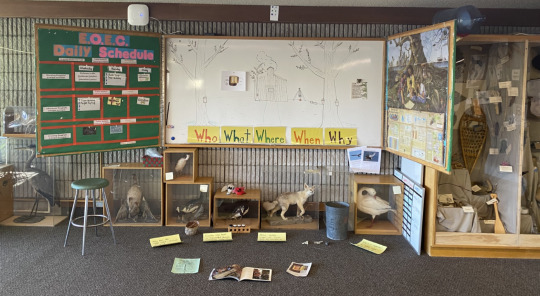
A picture I took of the main classroom at the Etobicoke Outdoor Education Centre.
At the start of my placement, I remember feeling disheartened by the number of kids who showed little interest and even apathy for being outdoors. I would wonder how these kids could not love being surrounded by the beautiful natural world. I quickly realized that many of these kids had never spent extended periods outdoors. This was due to limited access to the outdoors because of location, financial reasons and other limitations. These kids had little opportunity to gain a connection to nature, so it only made sense that few of the students had positive feelings toward natural environments. However, every week during this co-op placement, I got to help students with varying levels of outdoor experience explore new activities and gain a greater appreciation for nature, which was truly fulfilling.

A picture of a school group cross-country skiing at EOEC. This was many of the student's first-time cross-country skiing.
This course has allowed me to reflect on my time as an outdoor education intern and better understand the significance of nature interpretation in Environmental Education. As emphasized by Beck et al. (2019), interpreters work to communicate to people the importance of resources in a way that forges emotional and intellectual connections. Environmental education should provide emotional context that allows people to think ethically, creatively, and critically about environmental issues, solutions, and personal environmental stewardship (Wals et al., 2014). Environmental education is a form of nature interpretation that connects people emotionally with nature while providing them with tools to better understand environmental problems and solutions.
Connecting scientific knowledge with place-based and indigenous knowledge is essential for getting people to actively engage in sustainability (Wals et al., 2014). Nature interpretation programs such as those at outdoor education centres and National Parks create positive emotions toward nature and provide people with a sense of place (Beck et al., 2019). Nature interpretation provides individuals with the emotional connections and curiosity that allow people to appreciate the environment. Through interpretation, people may be inspired to learn more about nature and find ways to participate in environmental stewardship daily.

This is a board students used to track their class's eco-footprint challenge results while at EOEC. Students tracked the amount of food waste produced at the end of each meal, how many lights were left on before each program and water usage.
Additionally, nature interpretation programs that supply individuals with chances to engage in stewardship efforts on their own help people continue to build strong relationships with the environment. For example, in Washington Wachira’s Ted Talk, For the Love of Birds, he conveys to the audience the beauty and significance of birds by touching on the formative experiences that led him to his passion for birds (2017). Near the end of the TED Talk, Wachira tells the audience about citizen science programs around the world that people can take part in to help bird conservation efforts. This is an excellent way to show people that they too, have the power to help protect wildlife.
Citizen science enables people to participate in environmental stewardship by assisting with scientific research within their communities (Merenlender et al., 2016). Citizen science is a part of environmental education that further develops a person's scientific knowledge and sense of place in a fulfilling way (Merenlender et al., 2016). Like the eco-footprint challenge students participate in at EOEC, citizen science allows people to feel like they can take part in meaningful environmental stewardship efforts that make a difference.

Providing people with profound experiences outdoors through nature interpretation, environmental education, and citizen science is vital to environmental preservation. Nature interpretation provides the spark of inspiration needed to see the beauty in nature and the desire to preserve the environment that science alone cannot provide.
References
Beck, L., Cable, T. T., & Knudson, D. M. (2019). Interpreting cultural and natural heritage: For A Better World. Sagamore Publishing.
Merenlender, A. M., Crall, A. W., Drill, S., Prysby, M., & Ballard, H. (2016). Evaluating Environmental Education, citizen science, and stewardship through naturalist programs. Conservation Biology, 30(6), 1255–1265. https://doi.org/10.1111/cobi.12737
Wachira, W. (2017, August). For the love of birds. Washington Wachira: For the love of birds | TED Talk. https://www.ted.com/talks/washington_wachira_for_the_love_of_birds
Wals, A. E., Brody, M., Dillon, J., & Stevenson, R. B. (2014). Convergence between science and environmental education. Science, 344(6184), 583–584. https://doi.org/10.1126/science.1250515
4 notes
·
View notes
Text
Elden Ring: Miyazaki's Undiscovered Element
Here's my pitch: puzzle type #3 from The Witness (2016)
The first type of puzzle in The Witness is the one that the game is marketed for - a series of line puzzles on panels. The second type I won't spoil here. The third type is otherwise known as "perspective easter eggs". I am at this point reasonably certain that this is the so-called "last secret" of Elden Ring, or at least part of it.
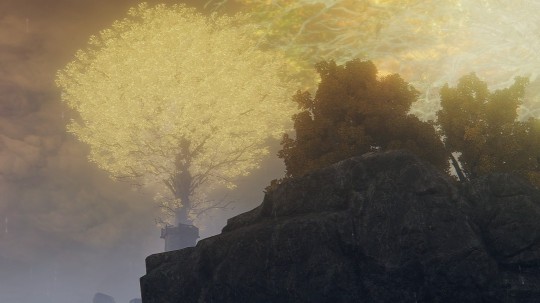
Firstly, to clear things up Miyazaki did not say that there was "one last secret" - that was a clickbait title invented by articles a few degrees removed from the original interview. The quote as presented in the IGN article is as follows:
“For me personally, there is a small element that I feel has not yet been discovered. So, whether that’s up to user interpretation or up to just further investigation and playing, that’s something I’m looking forward to....I think it’s a question of when and not if, but there may be something small still missing.”
Points of Comparison with The Witness: Forced Perspective
Here are some examples of what these perspective tricks look like in the Witness:




The statue in the foreground and the one far away on the mountain appear to be reaching for each other. The petrified man reaches for a gold chalice forever out of reach, but his shadow already holds the cup. A pair of wings is hung up in a window frame and you can pose your character in front. A small twig stands in front of a window and only from inside the building does it have a canopy made of cloud.
I have noticed similar set pieces in the environments of Elden Ring:
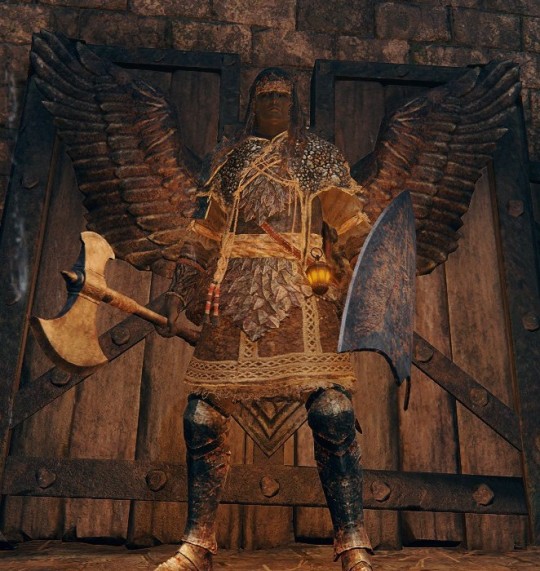
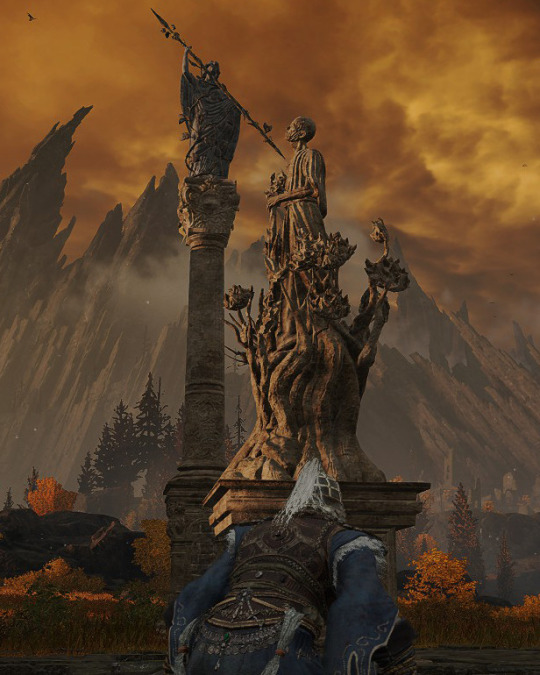
But here is where I think that Elden Ring diverges from the Witness. Simply finding these satisfying setpieces is half of the work, and the other half is puzzling over the meaning of the perspective, in the context of place and time.
Going through Castle Morne and thinking on what is in the field of view while standing in front of the wooden artillery boards with the metal wing decals. For example, there is a chamber to the left upon entering Castle Morne with no items or enemies inside it. Across from the entrance there is one of these boards. And looking into the little room from the perspective of a person desiring wings, you can see the significant thing about the room: two of the fire spewing dragon shaped flamethrowers that are not used at Castle Morne but are in use at Stormveil. Further examining the room, this is a manufacturing workshop for them.
The bald man cultivating one bud from a crucible producing many sunflower buds is menaced by a shadowy figure emerging from the firey Mt. Gelmir. Is there more to be observed with this one? Probably, as this set of figures occurs several times in sequence and the column with spear-holding figure appears in various states of repair. Something that I have noted is that there is a spike in complexity of these types of observations upon reaching Altus Plateau.
Another Elden Ring Innovation: Visions of Collectible Items
But let's say you are unconvinced about any particular meaning behind lining up a nice photograph at any statue. Here are some examples of scenes built around using items in the environment that can be interacted with:

Heading east of the Abandoned Coffin site of grace and up the hillside there is a place on the right-hand side just near the cliff with 1 carriage stacked on 2 others. At the top corner there is a purple soul item - which is a nascent butterfly. The camera can be angled so that it looks like the soul of the broken golem on the ground below.
Of other uses of nascent butterflies, there's the collapsing cliff at the Chapel of Anticipation - the goal is so close yet out of reach. There's a Wormface in the area under the bridge where Gold Mask first appears that is sobbing in front of a pool of water filled with gold fireflies and slugs, and directly across the pool from the Wormface there is a group of Nascent Butterflies.

And involving Scorched Butterflies: in the small Kaiden Mercenary encampment in Limgrave one of them is sitting and sleeping in front of the fire. Sneaking up and standing directly on top of the Herba behind him, there appears to be a soul item emerging from the stack of fire kindling on the left. The Scorched Butterflies here do not remain over the fire, but instead drift between fire and kindling. The item is actually obtained from a corpse behind the firewood and is the Armorer's Cookbook [1] that allows crafting of Fire Grease and Fireproof Dried Liver.

There is another notable place on the beach in Limgrave looking north where a Kaiden Raider seems to grieve over a corpse in its funeral pyre. A soul item "white flesh" emerges from the corpse, while Scorched Butterflies seem to rise above the flames and towards the Chapel of Anticipation in the distance. From standing at the location of the corpse, the sun sets beyond a rotten boat sitting on the shore.
The Last Sights of Dead Men: Iterating on Dark Souls
"There were once heroes who walked the battlefields, abundantly blessed by the Erdtree itself, who upon earning their honor simply died." - Hero's Rune
It is not uncommon to find corpses simply lying out in the open in many places in Elden Ring and holding "soul" items - by which I mean that they resemble the design of souls in the Dark Souls games. Some of these are unique weapons or key items, and some hold something more mundane like a handful of Stormhawk feathers. What were they looking at when they died? What are they running towards or away from? Standing on top of them, is there anything in the surrounding landscape that is perfectly aligned with another thing in a way that seems deliberate? Items in this game represent concepts - what insights did these dead men reach that caused them and the items they hold to be abandoned by the Greater Will and simply die in place?

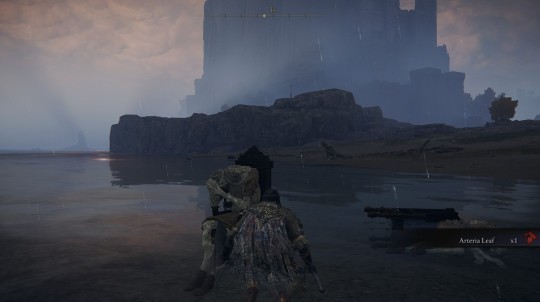
In the Weeping Peninsula there is a group of 4 angry jellyfish standing around 3 chairs with 2 corpses on the beach to east of Castle Morne. Looking towards the Weeping Peninsula Minor Erdtree with back against the middle chair (corpse holding Arteria Leaf), there is a visual illusion with the cliffside and wall turret that makes it look to be sitting in a little pot (this is the image used at the top of the post). This draws some connection between the genesis of the Erdtree and pots - a crucible is a type of pot. What is this little scene saying about the Crucible era? Another prominent feature here is that Morne Moangrave is visible, but the tree behind it does not become visible until walking far enough south on the cliff to coincide with two dark jellyfish on the lower beach becoming visible.
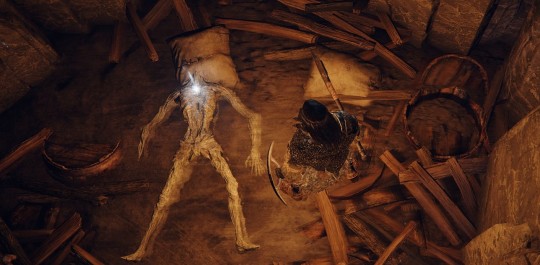
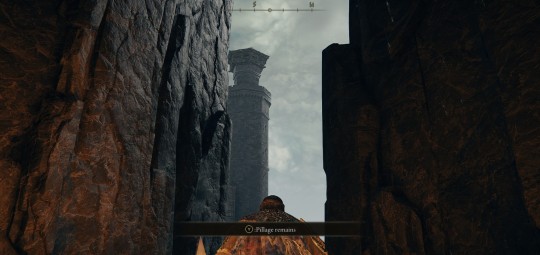

Behind Castle Morne there is a corpse lying in a crevasse which is posed with a bag over its head and being eaten by two crabs. The corpse holds 15 Fire Arrows and is looking directly towards a tower with a flammable 6-sided wooden structure at the tower top. There is also a small cut out in the cliff to allow clear sightline towards a single jellyfish which is very small beside the tall tower.

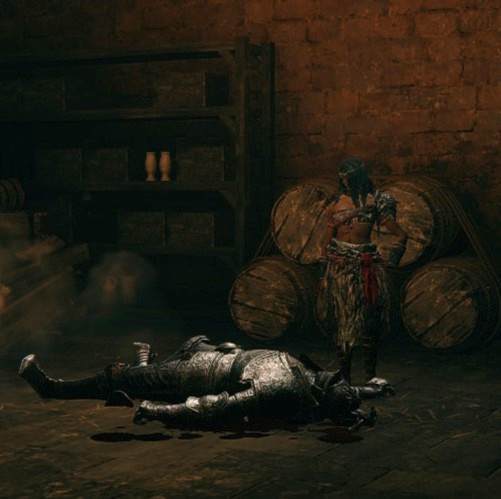
In the room in Stormveil where Nepheli Loux stands over the corpse of the Banished Knight, as you stand in the doorway the position where she's standing is right over his…codpiece. However, looking from the perspective of the corpse in the corner on the right she appears to be emerging from his head, like Athena from the head of Zeus.

From the vantage point of the corpse looking over the cliff behind the Church of Vows the Raya Lucaria Debate Parlour is haloed by the Liurnia South Erdtree. Things aligning with Minor Erdtrees from particular marked locations is a not uncommon observation. This corpse holds 8 Stormhawk feathers - can corpses be found with other quantities of feathers and strung together to show a sequence of travel? Is there a pattern in general behind sets of corpses that hold various quantities of common material items? One thing that this does imply is that there is a connection between the Liurnia South Erdtree and Radagon's arrival at Raya Lucaria, even though it is separated by distance from the Church.
Many Small Things that are Easily Overlooked
Essentially, for any static item found in the environment that can be picked up into the inventory there will be one or more notable observations in the landscape. I mean everything. Sites of grace. Rebirth monuments. Mushrooms. Rowa fruit. There are noticeable patterns where some tree or rock or other structure will be very deliberately placed in alignment or obscuring distant landmarks while standing at these locations marked by game mechanic objects. Landmarks such as the Erdtree, Divine Towers, the Minor Erdtrees, the Moon, and the Giant's Forge are common to take note of since they are so prominent, but any structure can be significant.
To show how finely tuned this can be - in this example Ranni's Rise is obscured when standing directly on top of the mushroom. Standing a metre to the right and the tower is again visible:


If nothing else, pausing to look around at these item points helps build an awareness that at many key locations on the map one or more divine towers will be in alignment with the Erdtree. This is quite possibly the only means of getting answers about what is the purpose of the divine towers - I'm guessing that they represent the influence of the Great Runes that they hold. Depending on which combinations of Erdtrees and towers are visible from the specifically marked points in the landscape it shows that the near location is in the domain of the distant landmark.
For example, the Liurnia Divine Tower is directly in front of the Erdtree from the Rebirth Monument at Laskyar Ruins, and 3 other divine towers are also visible from this location:
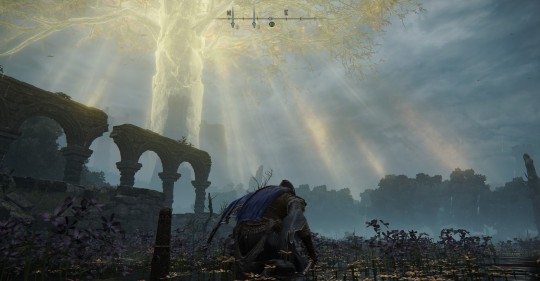
The types of common observations do depend on type of item. Patterns emerge that from the viewpoint standing on top of mushrooms there are distant landmarks very deliberately blocked by adjacent trees. Rowa Fruit Bushes are often found in pairs and there are subtle changes from comparing the two perspectives. Sometimes at Trina's Lilies it's more about what landmarks are blocked from sight until moving far enough away from them that it exceeds the draw distance of the item - as if the lilies are in hiding.
As with enemy difficulty, the environmental observations have scaling difficulty depending on the region of the map. Limgrave and the Weeping Peninsula seem to function as something of a tutorial zone for the Rowa Fruit Bushes especially. Liurnia has a lot more going on with the mushrooms and the time of day and visibility of the moon and sun are important. Altus Plateau does much longer sequences of tree alignment observations (starting from mushrooms), and keep an eye on the number of visible segments on the bolt of Gransax from any given location in Leyndell.
Why do I think that this is connected to the missing element?
I have seen a number of discussions popping up in the past few weeks of people noticing something that they have never noticed before and declaring that the "secret" is found. It's often something like an artwork detail or line of text that in retrospect has connection to the DLC. This is not special - I think we will find that a lot of things already in-game are connected to the DLC because - y'know - it's still the same game and the DLC is revealing a buried history that FromSoft always knew was there. I'm happy for people being more observant, but again it's a very limited interpretation of what a "missing element" or "something small still missing" could be.
And then there is the other part of the argument that Miyazaki is just trolling and saying that there is something small missing - when there is no possible way for him to have followed every discussion on what people have and have not seen.
But consider this: I am suggesting that there is an entire element of intended gameplay that is not being used. If people were serious about hunting for clues in the environment of the type that I have described there should be videos about it! Secret hunting streams, compilation videos, whatever. Articles with top 10 quirky photos you can take. I can happily run around for hours sneaking past all enemies and trying to observe them unnoticed from various angles like a virtual wildlife photographer.
And what I have shown is just the most aesthetically pleasing findings and "easy" spots to draw conclusions about. Think about how many corpses and how many items there are to interact with in the environment. Thousands. There is so much.
#Elden ring#environmental storytelling#3d perspective tricks#there is visual poetry everywhere#There's so much to interpret and I would like anyone else to please start looking
4 notes
·
View notes
Text
My Last Post
The time has come for our final blog post. This is the perfect opportunity to reflect and connect on the concepts we have learned. Throughout this course, we have learned that nature interpretation is a diverse and dynamic practice that can happen across various venues, using both personal an non-personal communication strategies to engage different audiences. The work of a nature interpreter involves direct storytelling, field interpretation, and technological tools to translate cultural and natural heritage into meaningful experiences. Interpreters are vital to helping people connect and appreciate museums, historical sites, arboretums, and natural landscapes such as national parks and forests. Whether leading visitors through a historical landmark or enhancing a hike with inside insights interprets educate and entertain. Overall, elevating experiences with a deeper understanding and personal fulfilment.
As I develop my sense of self as a nature interpreter, I recognize that this position holds more than sharing my passion for nature with visitors. My ethical responsibilities and personal beliefs will serve as a foundation for how I interact with audiences and the environment around me. We have learned that nature interpretation is more than stating scientific facts, it is about creating deep and personal connections between people and the environment. In the content, we now understand the different learning styles and how we communicate as nature interpreters can follow the ideals of interpretation. My personal ethic is rooted in inclusivity in communication to commit to teaching others how to respect nature. Throughout this reflection, I will explore the beliefs I will bring to this role, and the responsibilities I will sustain.

My experiences with my grandparents remind me of one scene in The Hunger Games, when Katniss is hunting in District 13 and a deer is not afraid of her and her weapon. Gale goes on to say “It’s because they have never been hunted before. It’s almost not fair.” It goes to show how nature also exists independently. When I am alone walking through trials, almost all of the animals run or move out of the way the moment they see me. This has made me want to try harder to form connections with nature, not just for myself, but for others. This goes hand-in-hand with the promotion of ethical nature behaviour. I would have to model and support this by educating visitors on how their actions can impact the environment.
A major concept of privilege in nature interpretation we learned during this course has stuck with me. Recall Peggy McIntosh’s article, she explains the concept of the Invisible Knapsack. Nature interpretation holds privileges too, such as who can engage in nature interpretation, who is included, and who isn’t. I believe that interpreters must be inclusive and everyone is deserving to have access to nature and the knowledge we bring to help them connect with it. I would make an effort to use engaging language, be accommodating to all learning styles, and respect cultural perspectives of nature. I think an important aspect of this issue is the poor recognition of how some communities cannot access nature. This could be due to historical rejection, socioeconomic barriers, or geographic location. As a nature interpreter, it is my ethical responsibility to spread this awareness and create a space where everyone feels safe. To do this, I would reach out to diverse communities and listen and learn from their stories and insights. I hope this will foster an inclusive and empowering for all audiences.
For me, I have always found that a hands-on approach with interactive learning is the most effective for engagement and comprehension. As a nature interpreter, I would provide guided walks or tours, in-person examples, and find ways for the visitors to actively participate to improve their learning. I think this would best reinforce information while also creating memorable personal experiences, that hopefully resonate with each individual. To utilize my in-person examples, I would incorporate storytelling to help further explain important concepts. This would include stories of history, my personal experiences, and local reports. I believe a well-told story can help remove the divide of scientific knowledge and emotion, by making facts into an experience.
Circling back to privilege in nature interpretation, I would be adaptive to each visitor's needs and encourage curiosity. It is important to make sure different interests and levels of expertise are acknowledged and implicated through my interpretations. I think one of my strengths is the ability to adapt approaches for children especially. I have been a nanny for 3 years for 3 kids ranging from infants to elementary school children. For the children, I would incorporate play into learning to make my work more engaging. For adults, I would encourage open discussions to help deepen understanding and touch on different areas of interest. Similarly, I would present myself as a guide rather than a figure of authority to further inspire curiosity.

This class has allowed me to develop my personal values and navigate the different responsibilities of a nature interpreter. When engaging with visitors, my ethical beliefs of the value of nature, awareness of privilege and the importance of inclusivity, I will be able to create enjoyable experiences for all. As an interpreter, I have responsibilities to provide correct information, create a sense of place, and inspire stewardship of the environment. Overall, my goal is to create experiences that are meaningful, and accessible, and foster deeper connections to nature.
References
Beck, L., Cable, T. T., & Knudson, D. M. (2018). Interpreting cultural and natural heritage: For A Better World. SAGAMORE Publishing, Sagamore Venture.
Gallavan, Nancy P. "Helping teachers unpack their 'invisible knapsacks'." Multicultural Education, vol. 13, no. 1, fall 2005, p. 36. Gale Academic OneFile, link.gale.com/apps/doc/A137921591/AONE?u=guel77241&sid=bookmark-AONE&xid=9fe2f151.
#nature#the good place#environmental interpreter#responsibility#morals#passion#community#inclusivity
2 notes
·
View notes
Text
Nature Interpretation Through History: Exploring the Depths of Integrity and Connection 🍂
This week, we are tasked with unpacking a thought-provoking quote from Edward Hyams (Chapter 7, The Gifts of Interpretation). He said, "There is no peculiar merit in ancient things, but there is merit in integrity, and integrity entails the keeping together of the parts of any whole, and if these parts are scattered throughout time, then the maintenance of integrity entails a knowledge, a memory, of ancient things…. To think, feel or act as though the past is done with, is equivalent to believing that a railway station through which our train has just passed, only existed for as long as our train was in it."
Wow, right? Hyams really hits the nail on the head with this one. He's diving deep into the importance of integrity, not just in history but inadvertently in how we interpret nature too. Let's break it down a bit further!
First off, Hyams dismisses the idea that ancient things have inherent value just because they're old. Instead, he hones in on integrity. He's saying that what really matters is keeping the parts of a whole together. Think of it like a puzzle. If the pieces are scattered everywhere, it's hard to see the big picture. This idea resonates strongly with what we've learned in class about the challenges of interpreting history accurately and authentically (Beck et al., 2018). Without maintaining the integrity of the past, our understanding of it becomes fragmented and incomplete.

Just as each piece of a puzzle contributes to the complete image, understanding nature through the lens of history requires piecing together various elements – ecological, cultural, and historical – to grasp the full picture.
Hyams also emphasizes the importance of knowledge and memory when it comes to maintaining integrity, especially with ancient things. This is where things really start to click with nature interpretation. Just as we need to remember and understand history to make sense of the present, we also need to do the same with nature. It's about connecting the dots between what was, what is, and what could be.
And then there's Hyams' analogy of the railway station, which I absolutely love. He says that thinking the past is done with is like believing the station only existed while our train was in it. It's a powerful reminder that the past is not some distant land we've left behind; it's still here with us, shaping our journey forward.
So, what does all of this mean for us nature enthusiasts? Well, it's a reminder to cherish the integrity of both history and nature. By understanding and respecting the past, we can better appreciate the present and make more informed decisions for the future. Just as we strive to preserve the integrity of ecosystems and landscapes, we must also honour the integrity of historical narratives. As future nature interpreters, this can be achieved via meticulous research, embracing diverse viewpoints, and presenting historical narratives in a manner that respects their intricacy and depth, as exemplified in the video featuring Robert Sutton, Chief Historian of the National Park Service (C-SPAN, 2012).

Direct Video Link: National Park Service Chief Historian Robert Sutton on Historical Interpretation in Parks (C-SPAN, 2012).
So, next time you're out in nature, take a moment to think about the ancient stories it holds. And remember, just like those stories, the past isn't something we've left behind. It's part of the journey, guiding us every step of the way!🦋 Until next time,
Madison B.
References:
Beck, L., Cable, T. T., & Knudson, D. M. (2018). Interpreting Cultural and Natural Heritage: For A Better World. Sagamore Publishing.
C-SPAN. (2012, May 2). National Park Service Chief Historian Robert Sutton on Historical Interpretation in Parks [Video]. YouTube. https://www.youtube.com/watch?v=tZ9DM-MoTXA
3 notes
·
View notes
Note
What do you think Nyo Ireland x Nyo Romano would be like?
Good question! Ultimately I don't think too much changes. Seamus takes care of Chiara and thinks her attitude is endearing, and Chiara really wants someone dependable and appreciates his sweetness (very similar to how Molly and Lovino function). However, there are some differences. Seamus and Molly both tend to short-circuit a little more when it comes to women, but Seamus thinks with his dick a bit more which can get him into trouble. Then you have Chiara, who acts pissy as a front when she really just wants a constant in her life. I think in a Nyo scenario it would take Seamus being more forward rather than the reverse for them to actually get into a relationship. I also think that Chiara is a little less eager to settle down than Lovino would be with Molly. Generally speaking, I think the two would go longer before putting a label on things, but they'd get there eventually. They'd probably fall into a more serious thing without even realizing it. I also feel like they'd have an easier time integrating into each other's families in this scenario.
#ask#my thoughts#hetalia#nyotalia#hws ireland#nyo!romano#iremano#idk i just think except for a few environmental things#only really the speed of the relationship and who initiates at first changes#bc i interpret some of the male characters as their nyos as an alternative#i just don't really see the nyos as their own separate characters#some gender-influenced things are a little different but the personality is pretty much the same
6 notes
·
View notes
Text
Bits & Bobs (Pt 1.)
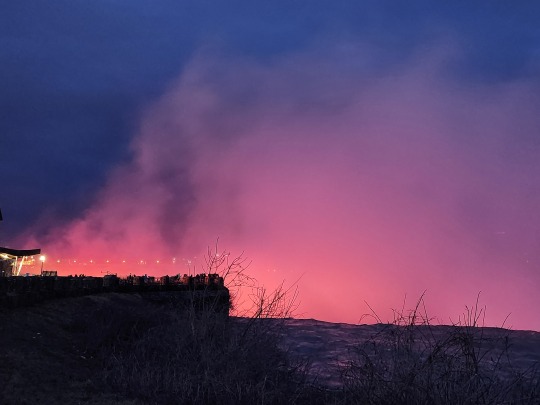
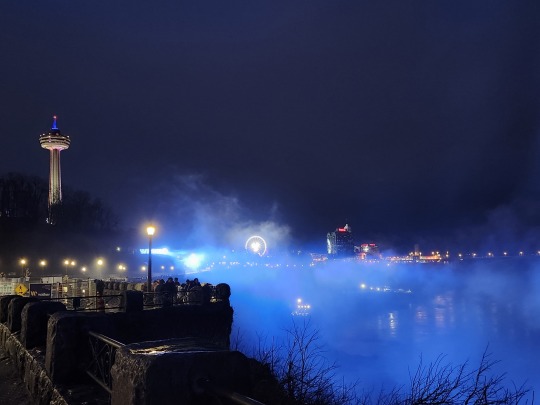
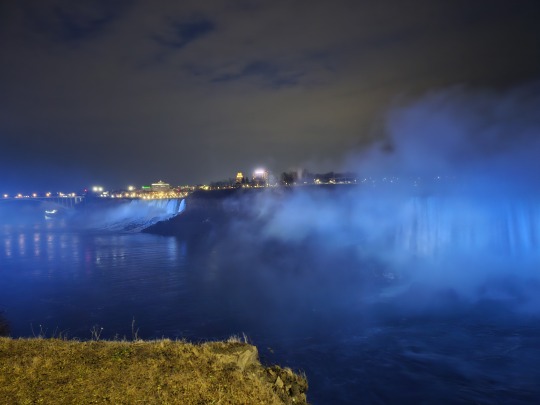
Lighting up the mist (plus skylines).

The most over-the-top concentration of tourist-hunting absurdity I have ever come across (and I say that with sincere fondness).
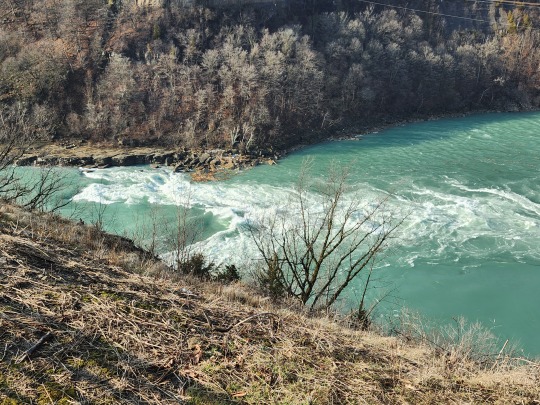
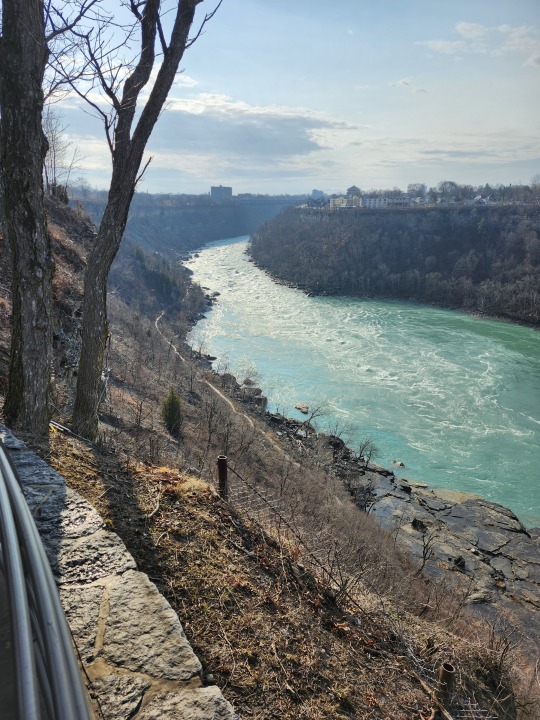
The Gorge - look at the blue of that water!
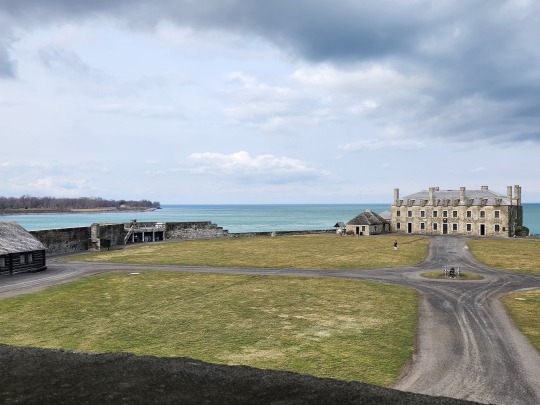

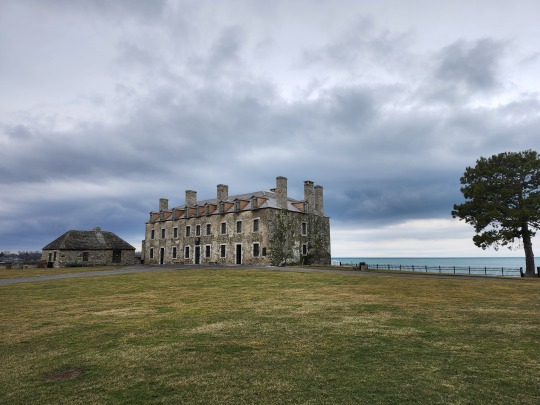

Of course I had to mix in some history - an interesting 18th Century French fort-disguised-as-trading-post (though not $19 worth of interesting); ft. a familiar-looking safe that I did not test for secret panels, and a very blurry Toronto taken from the opposite side of the Lake.
#it was much clearer in person#obviously even this new phone camera can't do everything#was even clearer today actually#the 'castle' did do a decent job of demonstrating the living conditions of the men assigned there#one of the only places it had decent interpretive materials#I did not descend into the Gorge 😅#I knew I'd need my legs for the urban walking#the commercial element is... I don't know#Niagara is very much the natural wonder that 'took one for the team'#in part that's because they were already luring tourists before the environmental movement even existed#they ended up protecting the very edges#and fairly well honestly#but beyond that it's a free-for-all#the Canadian side in particular is capitalism unleashed#my photos#free life
4 notes
·
View notes
Text
Learning, growing, and sharing the passion🐛🦋(U10)
Reflecting on my journey of developing my personal stance as a nature interpreter, I realize my ethos is deeply rooted in storytelling. While I would absolutely consider myself smart and capable of any challenge thrown my way, I wouldn't claim to be the one to ask for a perfectly articulated summary of a concept, or a history (or stats oh gosh...)) But! I am your girl if you want to talk about animals or nature with the same excitement and perception shifts you had as a kid; when learning about something like dinosaurs or other planets for the very first time and feeling like your mind was blown, or maybe even that the person was just making stuff up because of how wild it seemed.
At it’s core, my passion sings when having the chance to discuss niche topics with open-minds that delve into things like evolution, coming from the perspective that there are so many mysteries out there that could be unraveled if you only cared to look.
Just this week, some of these topics for me and some peers have included trying to understand bird tetrachromacy (how and why they can see in UV), mammals returning to the water like whales and dolphins, or how?? Literally how??? lemurs got to Madagascar.
To me, it's not just about sharing information, but having fun in the process and getting to share what you learn about the animals and their exploits in ways that would rival the wildest fantasy stories.
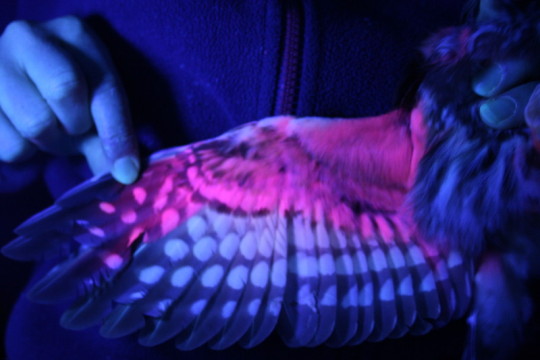
[Saw-whet owl wing under UV💡 ]
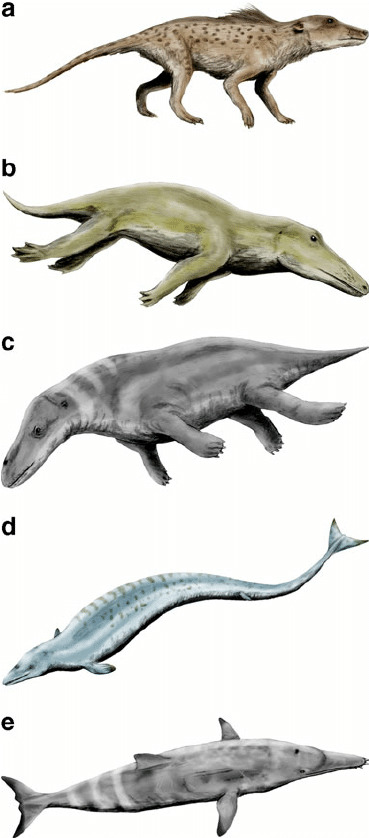
[OG whale💪🏻 ]
I've been playfully dubbed the "zookeeper of knowledge" by a friend in this context, after spending far too many hours working on a project because we kept getting side-tracked and discussing things not necessarily needed, but so incredibly interesting. (And it’s probably a title I'd gladly claim if it weren't so corny to be honest.) Regardless, it summarizes my commitment to becoming a curator of the captivating craziness that the animal kingdom has to offer. With a bias but passionate zoological perspective, I strive to share my spark of curiosity. ✨
Beyond my zoology lens, I strive for a focus on eco-consciousness in the work that I do, hoping to bridge the gap between science and the public and to foster stronger connection with Mother Nature.
As for translating these passions to children, I’m a firm believer in both transparency and honesty. While it’s almost guaranteed they won’t enjoy their first climate change lesson, I think forming traits of environmental stewardship and the understanding that actions have environmental consequences in children is critical if we want our passion for nature to be held by future generations. I remember my first lonely polar bear on a drifting ice berg video, and yes I was sad….but it left a vivid mark on my consciousness, shaping my understanding of the environmental challenges we face and it very likely brought me to where I am today.
Speaking of inspiring children, I cannot hold myself back as I have to show you guys what I found last week!
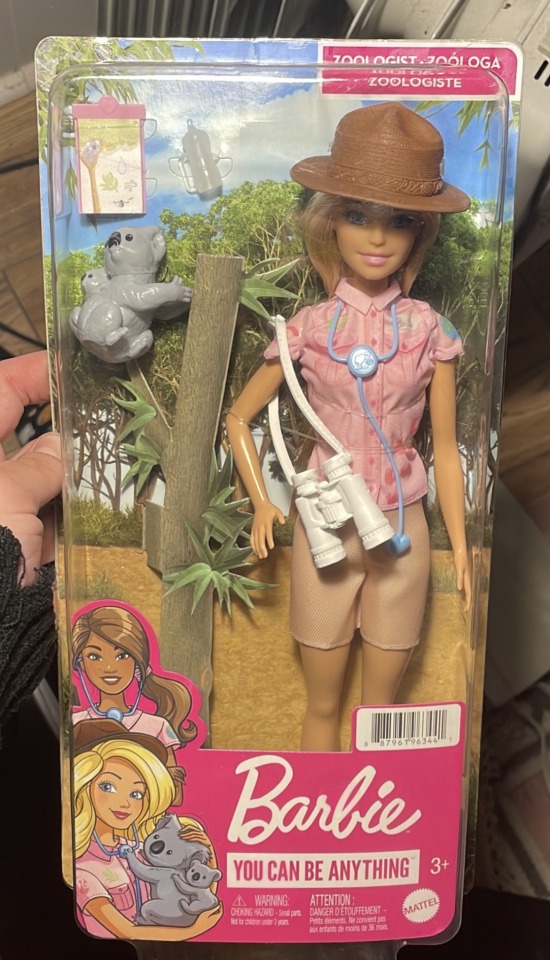
[Zoologist Barbie!!!!!!!!💗💗💗💗💗💗💗💗💗💗💗💗💗💗💗]
I'm not even that much of a Barbie fan but I think now I have to be! I would have exploded with joy if I had this as I kid! I mean, if Barbie is doing it, I can't even imagine how many little girls will now be exposed to the possibility of studying zoology or similar topics and I won't lie...I could cry 🥹 (not to mention how close the koala is to a lemur and my personal goals regarding that....interesting......verrry interesting 🔮)
Though I still think going outside with curiosity in mind is the number one way to develop a relationship with nature, I’d consider things and representations like this even more important in places like cities, where natural spaces are becoming less and less accessible due to never-ending infrastructure and the digital domination of screens and virtual experiences.
The allure of video games and online platforms often out-win outdoor activities at least in my own anecdotal experience, raising concerns about the disconnect between the younger generation and the natural world. I think environmental educators are becoming more and more important in schools, and I believe they play a pivotal role in counteracting this trend, as they offer opportunities for a child to focus on wonders within the natural world. I had a hard time myself trying to sound reasonable to many of my friends and family as a kid when saying I wanted to study animals and nature since technology was progressing so quickly and I was viewed as looking backwards.
and so I think this doll (or things similar) can reinspire or hold that flame when kids aren't yet to sure if they'll find a nice outdoor spot to explore, an educator excited to answer questions, or a community like Guelph that embraces natural sciences so much.
In my opinion, harsh climate crisis truths can surely be sugar-coated for young minds to an extent, but to completely wait until their old enough to ‘actually understand’ is just providing the perfect opportunity for a child to become a distracted or oblivious teenager or adult. Again, this is my opinion but at this point in time, in a current climate crisis with almost no signs of slowing down, being an adult in a country like Canada and purposely ignoring it is NOT cool!!
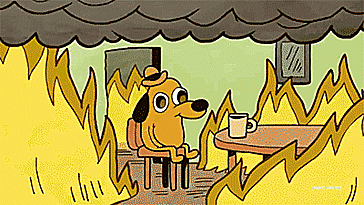
Now, we don’t have to live every moment with the weight of the world on our shoulders, and I don’t wish that on anyone! But I believe the absolute bare minimum is to consider our actions in relation to nature and provide the next generation the building blocks and exposure they'll need to make environmentally conscious choices. Concepts like reusable water bottles over disposable plastic ones, not littering, and realizing our planet belongs to others too aren’t scary things and if anything, promote cultures of care and community. These seemingly simple ideas start to lay the foundation for responsible and conscious individuals to gladly carry the torch of environmental awareness into the future!
Anyways, that's what's up with me, and so I hope you've found at least one thing on my blog that made you think about, reconsider, or learn something, and maybe even want to go hug a tree 💝🐛
Works cited
Johnson, N. A., Lahti, D. C., & Blumstein, D. T. (2012). Combating the Assumption of Evolutionary Progress: Lessons from the Decay and Loss of Traits. Evolution Education & Outreach, 5(1), 128–138. https://doi.org/10.1007/s12052-011-0381-y
Northern saw-whet owl outstretched wing under blacklight, by Seabrook Leckie, Attribution-NonCommercal-NoDerivs 2.0 Generic license, https://www.flickr.com/photos/rustyblackbird/
#nature interpretation#envs 3000#nature#zoology#zoologist barbie#climate change#environmental outreach#environmental education#barbie
3 notes
·
View notes
Text
Week 10
Describe your personal ethic as you develop as a nature interpreter. What beliefs do you bring? What responsibilities do you have? What approaches are most suitable for you as an individual?
I can't believe we’ve already reached the last post for this class, it feels like we had only just started.
For this week, we were asked to take a look into our personal ethics when it comes to nature interpretation. This was something I didn't really think much about until the start of this course, and going through the various blog prompts throughout the semester. I mean of course there were basic ethics that I knew were important, like to respect and appreciate the natural world. However, they were always in the back of my mind. I didn’t really take the time to really delve deep into it.
This semester we were given the opportunity to view nature interpretation through different lenses such as art, music, science, history, etc. I feel as though this allowed me to develop a sense of what I enjoy. I feel it's important to understand what you enjoy first, as it can aid in forming an ethical stance, because you can create personal connections, which leads to a deeper appreciation for the natural world. From this you can feel more motivated to take action revolving around certain environmental issues and it can allow you to understand conservation efforts. Viewing interpretation through different forms helped me enhance my ethical perspective, as there are many ways to perceive the environment.
Let's take a look at some examples.
Science was one of the more obvious ones for me. I mean when I think of nature, I typically think of the environment in a scientific way. This may be due to the fact I'm studying environmental science. For that reason, I already had some beliefs formed. Most if not all of the courses I take often touch upon environmental issues, whether it be climate change, pollution, endangered species, etc. Even before university, it was already engraved in my mind that we have to be mindful of the planet and how we treat it. Generally, to do what we can to limit our environmental impacts (negative impacts of course). Nature interpretation to me seemed like a form of delivering information to others, where they would learn the science/biology behind different environments. Generally, I believed that scientific knowledge would form a sense of responsibility as it shows the importance of conservation and sustainable practices. While that can be the case, I've learned that there is much more to it as well.
Now, as for viewing nature interpretation through art. While I knew that art can portray many messages and meaning, I didn't really think of ‘art’ when I thought of nature interpretation. However, after going over previous readings and blog posts I learned to see a different perspective. Art allows us to form emotional connections with nature. It can evoke feelings of empathy and appreciation for the natural world. This is when I realized, paintings, photographs, music, etc. all play a crucial part when it comes to nature interpretation.
History was another form that I knew was crucial to learn about when it comes to nature interpretation, but I never really put much thought into it like I did with science. I believe now that in order to form beliefs surrounding nature I need to recognize and learn about the history first, as it provides context. History can show us both the positive and negative impacts humans have had on the environment. When we understand the consequences of past actions, we can form ethical decisions for the future.
Generally, I learned that nature interpretation doesn't have to follow a structured format. Instead there are various ways to view nature interpretation, which seems obvious to me now. I feel as though this wasn't so obvious when I first started this course because typically the courses I took prior (science based) followed fairly structured formats. Now, as a nature interpreter, I've learned that I'm responsible to consider multiple perspectives, but also provide differing perspectives to others. While I also enjoy the science side of interpretation, I’ve learned to enjoy and am open to other forms as well. I've learned that as a nature interpreter I am responsible to bridge the gap between people and nature in ways that are accessible, relatable and compelling. In this week's reading on courselink we were asked the question “what motivates you to do this work?” While my love and appreciation for nature keeps me motivated, I also think what I've learned through this course would have an effect on this. I've learned to recognize the significant effect nature interpretations can have on others by recognizing the forms of nature interpretation that have played a crucial role in my life in shaping what I want to do today. I think it was important to realize the effect that nature interpretation has had on me to realize I can have that same effect on others. I’ve learned to be mindful of how I both present and obtain information.
Overall, I'm grateful for what I have learned in the course, and will remember to carry on to this information for the rest of my nature interpretation journey.
3 notes
·
View notes
Text
(If you're wondering what I'm talking about re: physical components of mental illness in TLT, I saw a post discussing how the section of HtN from Ianthe's POV mentions some structural abnormalities in a part of Harrow's brain that are consistent with common structural differences in the brains of individuals with schizophrenia. However I can't find that post now and I don't have the book handy.)
#the locked tomb//#mental illnesses are a complicated interaction of biological environmental and cognitive elements#I don't want someone interpreting my recent posts as suggesting it's all 100% one or the other#however I assume that detail was included in HtN intentionally
13 notes
·
View notes
Text
How does one analyze the portrayal of nature in Middle Eastern landscape paintings?
Analyzing the Portrayal of Nature in Middle Eastern Landscape Paintings: Exploring the Beauty and Symbolism Introduction Middle Eastern landscape paintings offer a captivating glimpse into the region’s natural beauty and the artistic interpretations of its landscapes. From serene desert vistas to lush oasis scenes, these artworks depict the harmonious relationship between nature and human…

View On WordPress
#analysis#artistic interpretations#artistic style#beauty#color palette#composition#cultural context#Cultural significance#cultural traditions#cultural values#emotional responses#environmental awareness#environmental challenges#harmony#human interaction#inspiration#lighting#Middle Eastern landscape paintings#natural environments#nature#portrayal#preservation#regional landscapes#regional variation#responsible stewardship#spiritual significance#sustainability#Symbolism#techniques
4 notes
·
View notes
Text



8-18-23
#nature photography#hiking#nature trail#river#u of m dearborn environmental interpretive center#water#trees#dark nature#august#end of summer
5 notes
·
View notes
Text
been thinkin about the worldbuilding in minecraft again
#paq.txt#trying to piece things together based on the environmental storytelling w/in the game#+ the interpretations various mcyt have created is So Much Fun#also. piglins. minecraft popped off w/ piglins#endermen are also up there as one of my favorite mobs but fucking piglins man. i could think about those hogs all day
2 notes
·
View notes